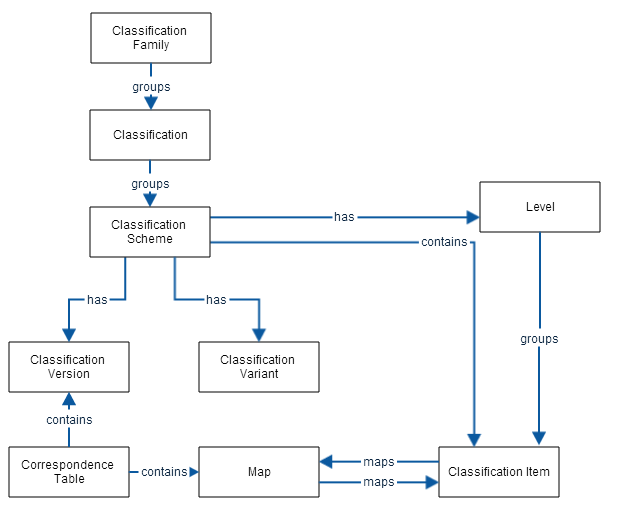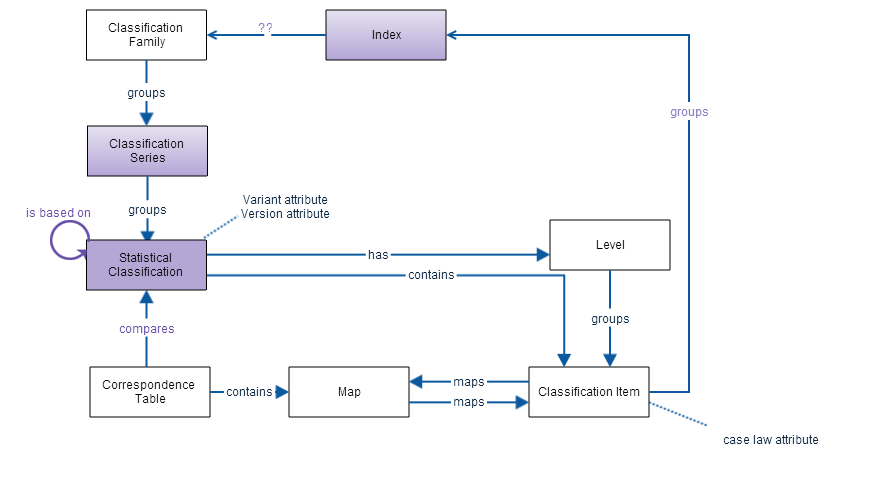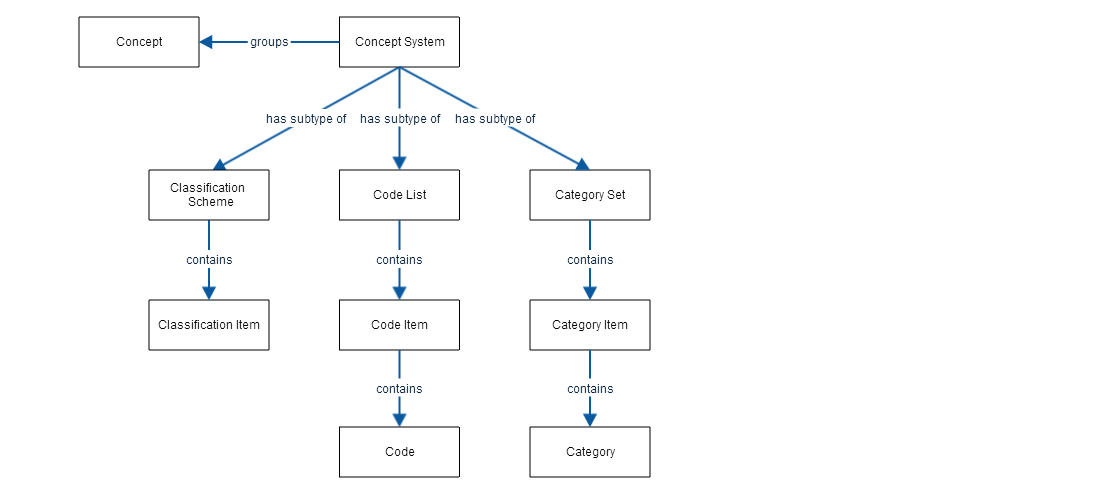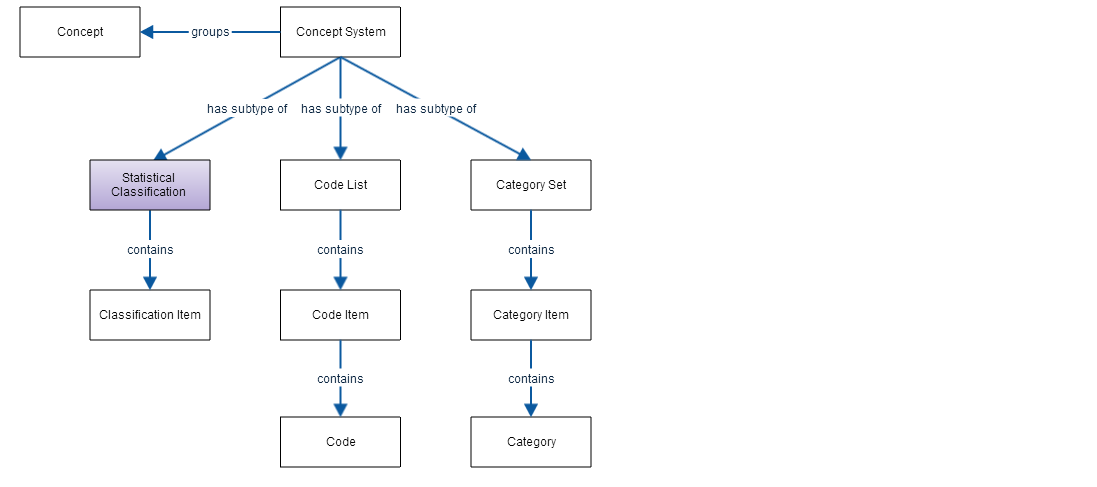Current proposal from Group
During the METIS meeting in May 2013, it was agreed that the relationship between Neuchâtel and GSIM should be reviewed.
After this meeting, the Neuchâtel working group met with the GIG and it was agreed that the Neuchâtel working group would bring a proposal about how to harmonise/ align the two models at the end of July. After a number of discussions, the Neuchâtel working group would like to put forward the following proposal to the GIG.
Neuchâtel and GSIM working together: A two part proposal
1) It is proposed that Neuchâtel becomes part of GSIM. This means that the terminology used in GSIM and Neuchâtel is changed so that there is complete alignment. As such it is proposed that changes are made to the GSIM Specificiation layer in terms of objects, definitions, attributes and relationships (the proposed changes are detailed below).
2) Neuchâtel contains some excellent detail that is very useful to people implementing it. This level of detail is too detailed for the GSIM Specification layer (the current most detailed level of GSIM), but is necessary for those working with classifications. In addition to the changes made to the GSIM Specification Layer, an annex will be written which includes this finer level of detail.
The annex will be able to stand in its own right as a document. It will align completely to the GSIM Specification Layer and will reuse / update much of the content of the current Neuchâtel document. The creation of this document will be the responsibility of the Neuchâtel working group.
The Neuchâtel working group asks that the GIG consider their proposed changes to the classification objects in GSIM.
The proposal is outlined in the diagrams and tables below. Please note that the attributes and relationships pertaining to classification index entries is still being fine tuned by the group.
Current GSIM picture

Proposal from this group (purple indicates a change to object name or relationship)

Detailed proposed changes to GSIM:
| Current GSIM Object | Proposed change | Revised Name | Revised Definition | Revised Relationships |
|---|---|---|---|---|
| Classification Family | Change definition | Classification Family | Definition: A Classification Family comprises a number of Statistical classifications, which are related from a certain point of view. The family may be based on a common Concept (e.g. economic activity). Explanatory notes: Different classification databases may use different types of Classification Families and have different names for the families, as no standard has been agreed upon. Source: revised Neuchatel | A Classification Family groups Classification Series Potential relationship to Classification Index to be added |
| Classification | Change name Change definition | Classification Series | Definition: A Classification Series is an ensemble of one or several consecutive Statistical Classifications under a particular heading (for example ISIC or ISCO). Explanatory notes: Source: revised Neuchatel | A Classification Series groups Statistical Classifications |
| Classification Scheme | Change name Change definition Add attributes of version and variant Add self referential relationship | Statistical Classification | Definition: A Statistical Classification is a set of categories (Classification Items) which may be assigned to one or more Units in statistical surveys or administrative files, and used in the production and dissemination of statistics. Explanatory notes: The Classification Items are defined in terms of one or more characteristics of a particular Population of Observation Units. A statistical classification may have a flat, linear structure or may be hierarchically structured, such that all Classification Items at lower levels are sub-groups of the next Level up. The Classification Items at each level of the classification structure must be mutually exclusive and jointly exhaustive of all objects in the target population. Source: David | A Classification Series groups Statistical Classifications A Statistical Classification can be based on a Statistical Classification A Statistical Classifications has Classification Items A Statistical Classifications has Levels A Correspondence Table compares a Statistical Classification |
| Classification Version | Remove from GSIM model Add as attribute of Statistical Classification | -- | -- | -- |
| Classification Version | Remove from GSIM model Add as attribute of Statistical Classification | -- | -- | -- |
| Level | Revise definition | Level | Definition: A Statistical Classification has a structure which is composed of one or several Levels. A Level often is associated with a Concept, which defines it. In a hierarchical classification the Classification Items of each Level but the highest are aggregated to the nearest higher level. A linear classification has only one level. Explanatory notes: Source: revised GSIM | A Statistical Classification has Levels A Level groups a Classification Item |
| Classification Item | Change definition Add attributes of case law | Classification Item | Definition: A Classification Item represents a Category at a certain Level within a Statistical Classification. It defines the content and the borders of the Category. A Unit can be classified to one and only one item at each level of a Statistical Classification. Explanatory notes: Source: revised Neuchatel | A Statistical Classification has Classification Items A Map maps to a Classification Item A Level groups a Classification Item |
| Map | Revise definition | Map | Definition: An expression of the relation between a Classification Item in a source Statistical Classification and a corresponding Classification Item in the target Statistical Classification. Explanatory notes: The map should specify whether the relationship between the two categories is partial or complete Source: revised GSIM | A Correspondence Table contains a Map A Map maps to a Classification Item |
| Correspondence Table | Change definition | Correspondence Table | Definition: A Correspondence Table expresses the relationship between two Statistical Classifications Explanatory notes: These are typically: two versions from the same Classification Series; Statistical Classifications from different Classification Series in the same Classification Family; a variant and the version on which it is based; or, different versions of a variant. In the first and last examples, the correspondence table facilitates comparability over time. Correspondence relationships are shown in both directions. Source: Revised Neuchatel | A Correspondence Table contains a Map A Correspondence Table compares a Statistical Classification |
| ---- | Add new object | Classification Index (the group is still discussing exactly what this object should be - including the exact definition, attributes, explanatory text and relationships) | Definition: A Classification Index is a list of words or text strings (e.g. the name of a locality, an economic activity or an occupational title and task) that refer to Classification Items refer to Classification Items in one or more Statistical Classifications from the same Classification Family. Explanatory notes: A Classification index shows the relationship between text found in statistical data sources (responses to survey questionnaires, administrative records) and one or more Statistical Classifications. A Classification index may be used to assign the codes for classification items to observations in statistical collections. A Classification Index may be presented in alphabetical order of the text, in code order, or searched electronically. Source: Revised Neuchatel | To Be Confirmed A Classification Index groups Classification Items A Classification Index [ something ] a Classification Family |
Current GSIM picture

Proposal from this group (purple indicates a change to object name or relationship)

5 Comments
Jenny Linnerud
Does a variant and the version that it is based upon belong to the same Classification Series or not? This is not clear from the definition of the Classification Series. An example could be given or some explanatory text could be provided to cover this.
Jenny Linnerud
Some of the relationships need to be improved e.g. For Correspondence Table: A Correspondence Table compares
aStatistical Classifications. For Map: A Map mapsto aClassification ItemsJenny Linnerud
Index: I do not believe that there should be a relationship betweeen Index and Classification Family. However this may be based on my assuming that Index here is like the Classification Index or Classification Index Entry in the old Neuchãtel. The potential relationships would then be to Statistical Clasification and/or Classification Item, but not Classification Family.
user-43b9a
I've two questions:
user-8e470
In answer to question 1, the neuchatel group were keen to keep the object as statistical classification. The reason for this is that the restrictions in our definition (e.g mutual exclusivity and exhaustiveness) may only apply the classifications used in within the statistic world and not outside.